The Birth of the Blakely Burl Tree Project
The
threads of seemingly unrelated events, ideas, experiences and chance meetings
from which the story is woven make a particularly satisfying tale.
If you want to go back far enough, you could decide the Project had its origins
nearly two thousand years ago when the Native American Woodland People of the
South Georgia region started using fire to promote healthy forest growth,
including the pecan trees that produced the nutritious nuts that supplemented
their diet. In fact the region, more than any other part of the United States,
still heavily depends on pecan trees to provide part of the national diet. The
pecan trees have always been part of the story, both in the minds of the
participants and in the Burl Tree itself.
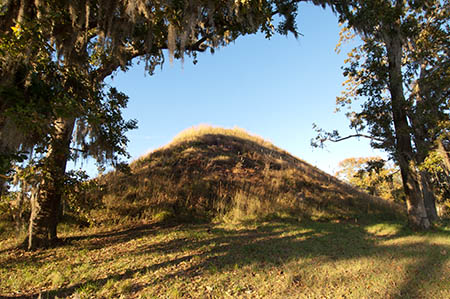
Kolomoki Indian Mound - Blakely, GA
Photo: John McFadden
More significantly, you can say
the Project began when a single pecan was lifted high on swirling flood waters
and carried away to lodge on the east bank of the gully that ran through the
site of the town of Blakely in Early County, Georgia. Out of the hundreds of
millions of pecans that must have swirled downstream over thousands of years,
that pecan carried with it the genetic predisposition to grow in such a way that
when it was a mature tree it would become the focus of international attention.
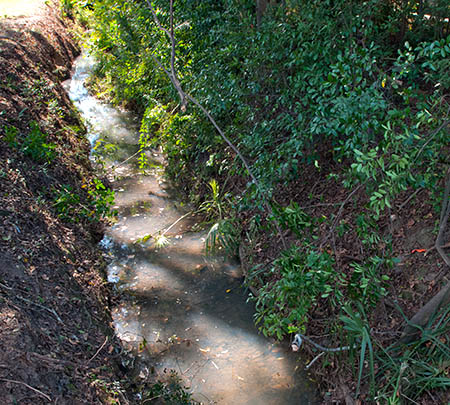
The "Big Ditch" Blakely, GA
Photo: John
McFadden
For decades the tree grew inch by
inch, steadily locking its roots into the bank of the gully that had
unromantically become known as the Big Ditch. When J.B.
Rice built the J B Rice Plumbing & Electrical Co. within a few feet of the Big Ditch, he started the family connection to
the tree. If the shop, or the tree, had been in any other place, the Project
would never have come about. It seems appropriate that for fifty years J.B. Rice
bought and sold pecans from his shop while the unusual tree quietly grew behind
the building.
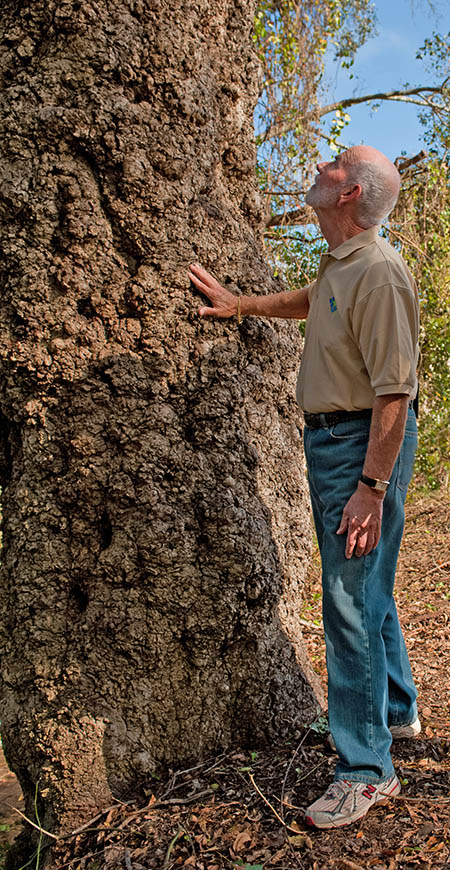 |
Time passed and J.B.’s son
Charles came to play at his father’s shop. The young adventurer Charles used to
slip behind the building and explore the gloomy banks of the Big Ditch. For him,
the tree was one among many and he had no idea what it would come to mean to him
and his home town, as he explains: "It was already a pretty big tree when I was
growing up. I used to chop that old tree with the hatchet I always carried in my
belt and even drove nails into it, but luckily it didn't do any harm." Time
passed and Charles, moved by his own genetic predisposition to grow, moved out
of Blakely to Atlanta where he would eventually achieve phenomenal success in
business. |
| Charles
Rice (left), in November, 2009, gazing at the burl tree he used to play
around as a boy.
Photo: John McFadden |
Later, Charles’ son Barton would
return to Blakely every year to spend his summer vacations with his
grandparents. He recalls those idyllic days: "No matter what time of the day it
was, it always seemed like it was late afternoon with the lazy hot sun on the
horizon. We ran around barefoot and bruised our heels from stepping on pecans in
everybody’s front yard. Everyone had a pecan tree. The Big Ditch was always all
murky shadows with snakes and other things you didn’t want to play with. I was
not supposed to be behind the shop playing, but when my grandfather was helping
a customer I’d sneak out there. I remember the burl tree. It was this horribly
misshapen, gnarled thing. The space between the back of the shop and the creek
was probably only around three feet, so you had to negotiate getting by that
tree." Barton grew up, graduated from college and eventually joined the family
business – and the tree continued to grow.
In 2004 Charles’ mother, Mary Kathryn Patrick Rice, passed away. Katha was born
on February the 22nd and she passed away on February the 22nd, exactly 93 years
later. Charles and his extended family returned to his home town for her
funeral, together for the first time in over thirty years. He was filled with
thoughts of family and family roots and was saddened to see that a town he
remembered as a vibrant community with a rich life had become run down and that
many of the residents had become dispirited about the future of Blakely.
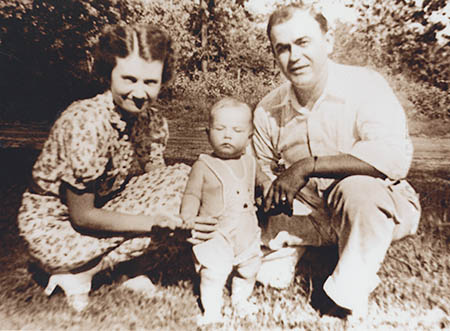 |
|
| |
The Rice Family - (left) Mary Kathryn, (center) Charles Rice-1 yr old, and Jean Barton
Rice (right) in Blakely, GA , 1937 |
Barton explains: "My dad was
saddened by the changes. He’d say, ‘That old building used to be a store and now
it’s all run down,’ or ‘I used to buy groceries there and now the building’s
gone.’ My grandfather’s shop hadn’t been used for twenty years and the roof was
caving in. We realized that the town hadn’t had the affection that it once had
and that it needed some help."
Charles was struck with the idea
of creating a project to rejuvenate his home town and in this way the Early
County 2055 Project began. Charles assembled a team, headed by his son Barton,
and his childhood friend Stanley Houston, and a fifty-year plan was developed with the aim of restoring quality of life
and economic viability to Early County.
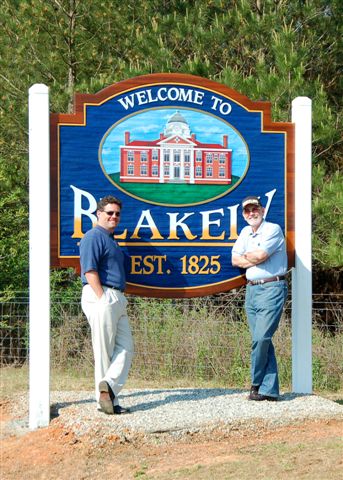 |
|
|
Barton Rice (left), and father Charles Rice (right) March 29, 2007, in front
of Blakely, GA, welcome sign provided by Rice family in this and 8 other
locations in Blakely Georgia. |
The 2055 Project will be described in
more detail elsewhere, but its significance for this story is that Charles
started to acquire land for the project, including the land where his father's
former shop still stood, and he tasked Stanley Houston with managing the acquisition of land. On
top of the already unlikely twists of fate, now a series of supremely
serendipitous occurrences came about.
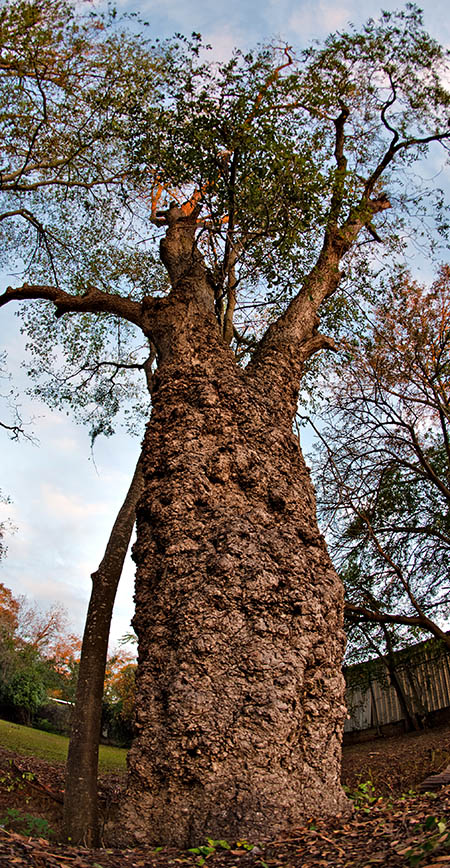
Photo: John McFadden |
Charles and Catherine had
commissioned Marty Weck to make a replica of the Blakely Courthouse and he was
visiting the town to place the replica on display in the lobby of the
Courthouse. Stanley was showing Marty around the town and he decided to show him
the site where Charles wanted to establish a memorial garden to his parents on
the site of the old shop. “I don't know why I did what I did on that particular
day,” says Stanley, “but I pulled in at the shop site and we walked around to
the back of the building.” Marty Weck said to Stanley, "Do you know what you've
got there? You've got a burl tree." "What's a burl tree?" replied Stanley. It
was a question that soon would be repeated many times by different people.
You could say that was the moment
when the Burl Tree Project was born. If Marty Weck had not advised Stanley that
the tree might be a source of rare and beautiful wood, it almost certainly would
have been chipped with all the other trees along the bank when the site was
cleared. Stanley knew that Charles Rice was still searching for a way to honor
his mother and father, so he called Charles and told him, "I think I just found
your answer." He told Charles about the tree and Charles made contact with
several people in Atlanta to see if they could investigate the potential of the
tree. As he was not able to learn any more from them, he asked Stanley to find
out if anybody nearer to Blakely would be able to advise them.
|
Stanley admits that, "At that
time we didn't really have a clue. Marty told me that the wood might have really
interesting grain, so we were thinking about nice furniture like a conference
table, or veneer for paneling in Charles’ office. We didn't know who could
confirm it was a burl tree and we didn't know who could process it." J.B. Rice’s
shop was soon demolished and on that day the tree that for generations had
remained hidden between the scrubby foliage lining the Big Ditch and the back of
the shop was fully revealed for the first time. Stanley knew he had to find out
more about the tree.
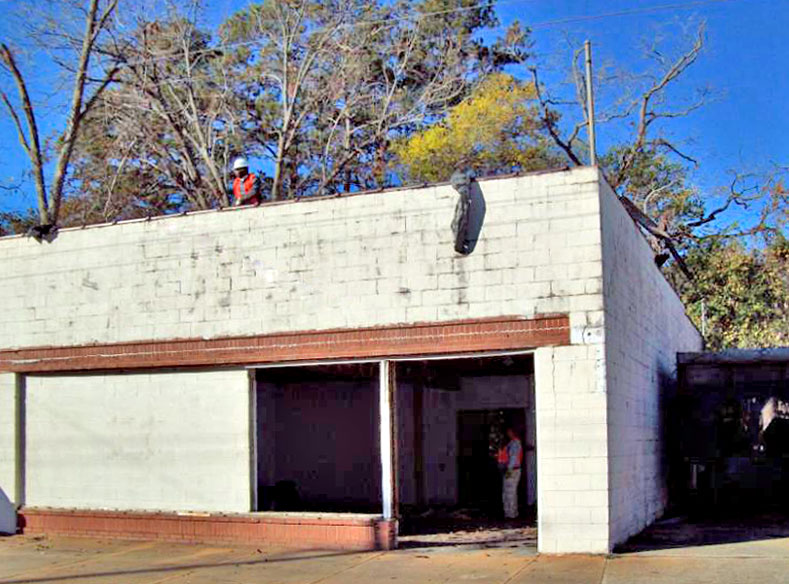
The J. B. Rice Shop in Blakely, Georgia, being torn down.
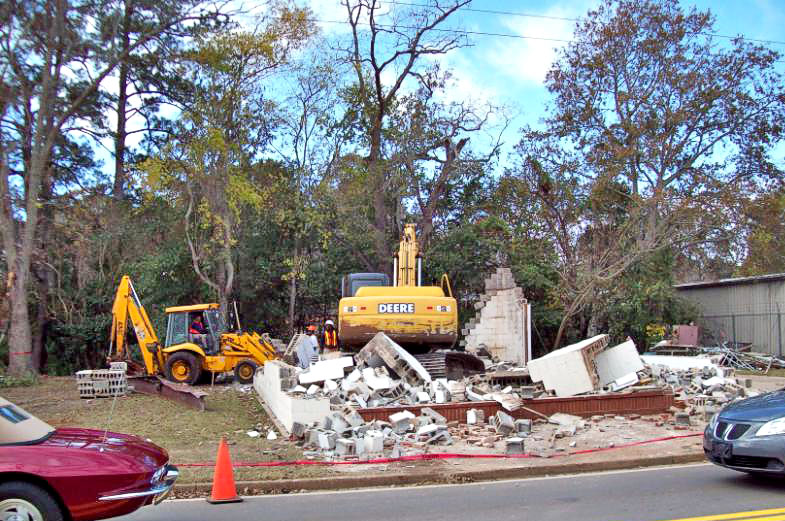
As the shop is demolished, the Blakely Burl Tree comes into focus.
In another one of those amazing
coincidences, Stanley had met Steve Cross, a fifth-generation sawyer from nearby
Iron City, about one year earlier. "I'd been carrying Steve's phone number
around in my pocket for months, but I'd never called. I decided Steve might be
able to help us, so he came and looked at the tree."
Steve is a specialist sawyer who
works closely with skilled artisans to get the very best from every tree. Once
he saw the tree he realized that he had just met the ideal person to advise
everyone on what they had found. Steve told Stanley that only two weeks before
he had met Mark Lindquist, who lives in Quincy, Florida, less than two hours
from Blakely.
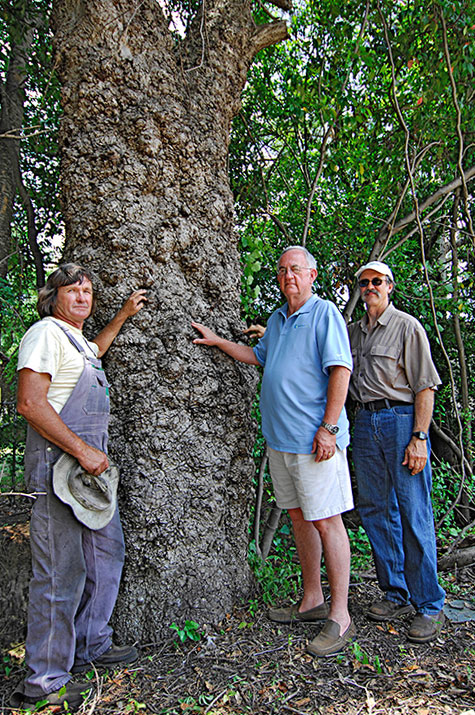
Steve Cross (left), Stanley Houston (center)
and Chris Smith meeting at the Blakely Bur Tree.
Photo: Mark Lindquist
It would be no exaggeration to
say that in all of the United States there is no person better suited to
advising on such a tree. Mark Lindquist’s history as a woodsman, artist and
creative thinker meant that he was uniquely placed to understand its potential.
He came and inspected the tree and confirmed that it was indeed a rare specimen.
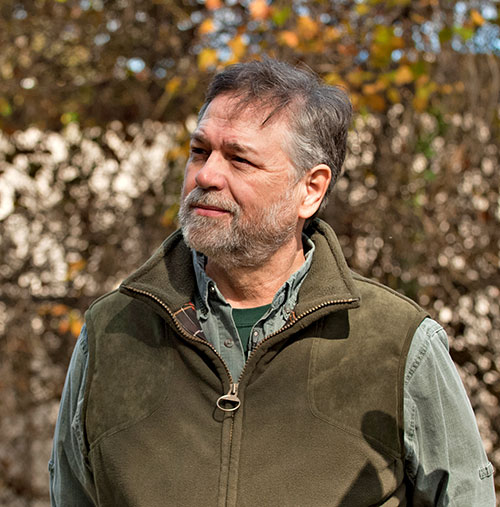
Mark Lindquist, artist, woodworker,
photographer
Photo: John McFadden
Soon Mark was introduced to
Charles Rice who recognized the can-do spirit that Mark brings to any idea, so
he asked Mark to make a proposal for a project that would immediately focus the
energies of the Early County 2055 Project. Mark did so, Charles delightedly
accepted the proposal and at that moment the formal Blakely Burl Tree Project
was born.
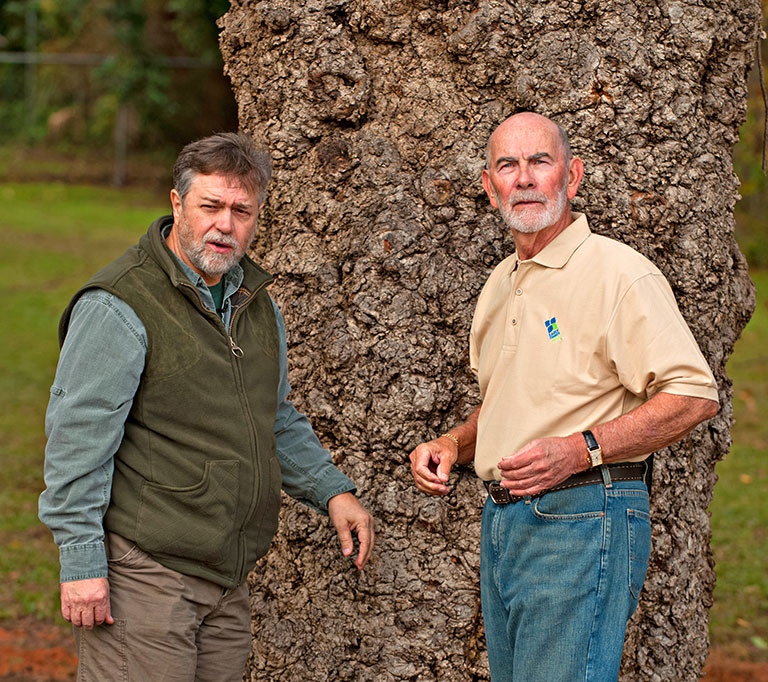
Charles B. Rice Sr., (right) and Mark
Lindquist with the Blakely Burl Tree.
Photo: John McFadden
What follows is the unique story
of what happened to the tree. We will follow its journey through the assembly of
a remarkable team of experts, the respectful harvesting of the tree, the
painstaking milling of the tree into sections chosen for the best use of its
qualities, selection of artists from around the world to bring the potential of
the wood to reality, the sometimes joyous and always painstaking process of the
creation of Burl Tree art, its reassembly in its birthplace, and its triumphant
presentation to the people of Blakely and the wider world.
The truth is that the Blakely
Burl Tree was an unlikely survivor. It had grown largely unnoticed, unattractive
and unappreciated. If it had been more accessible it probably would have been
chopped down for firewood long ago. Now it has become the focus of intense
interest and hope.
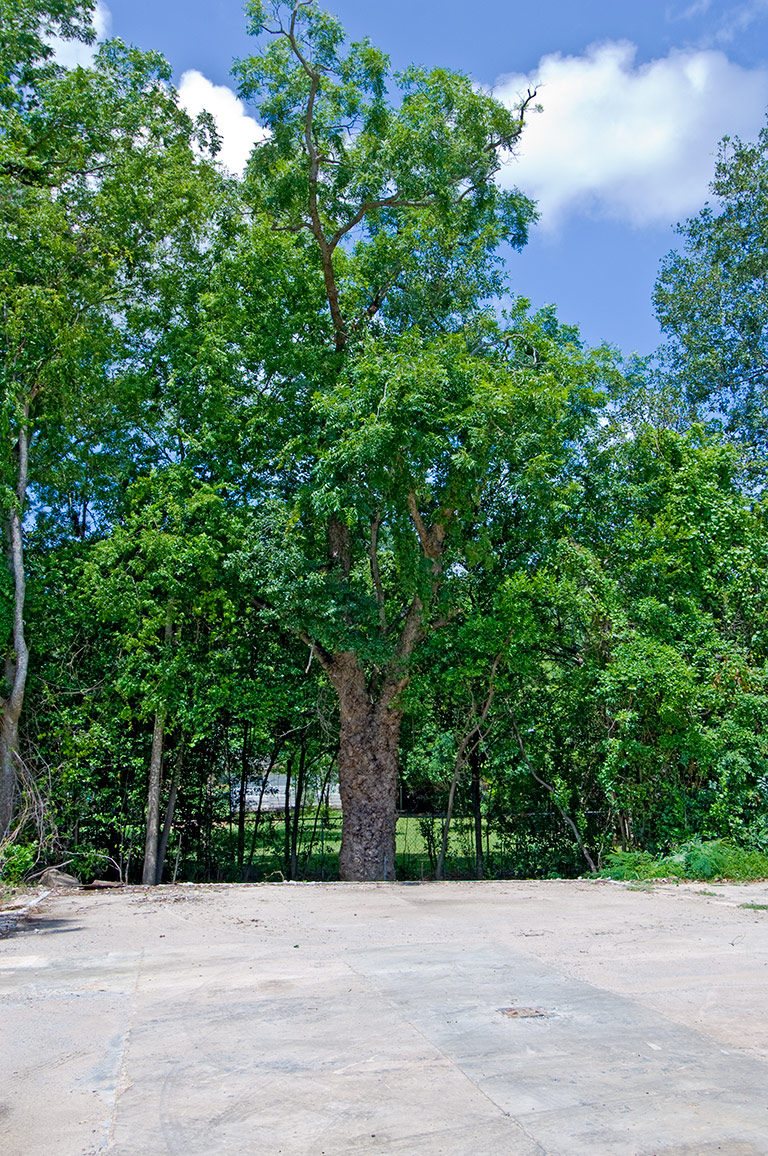
The Blakely Burl Tree revealed after the J.B.
Rice shop was torn down.
Photo: Mark Lindquist
When we look back over the events
leading up to the Project's inception, it is hard not to be amazed by the thin
but unbroken thread of circumstance that led to its birth. If that pecan had not
lodged where it did…if J.B. Rice had not built his shop right in front of it…if
Stanley Houston had not taken his visitors behind the shop – and so on through
all the chance occurrences that meant the right people were able to meet.
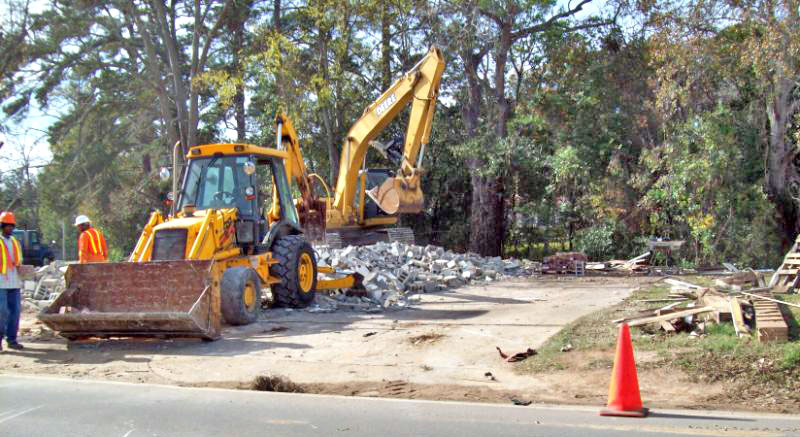
Demolishing the J. B. Rice shop reveals the Blakely burl tree which had been
growing behind it.
The timely recognition of this
once-in-a-lifetime opportunity allowed a remarkable team of varied skills and
backgrounds to be assembled. The project will ultimately belong to the community
of Blakeley, although for a time the tree will be entrusted to outsiders who
will help realize its full potential. The threads of history and circumstance
that make up the burl tree story were sometimes thinly stretched, but they
remained strong and were finally woven together in 2009. Was it all mere
coincidence? Many of the good folk of Blakely believe it was the answer to
sincere prayers.
NEXT>